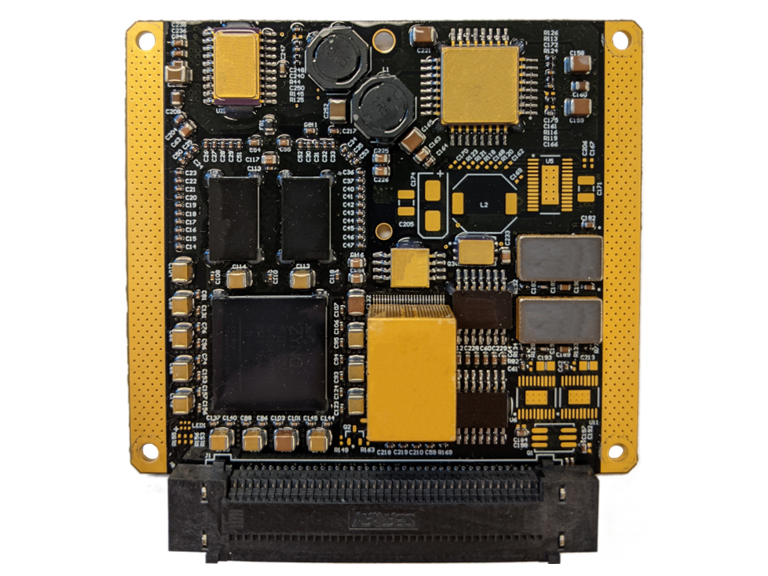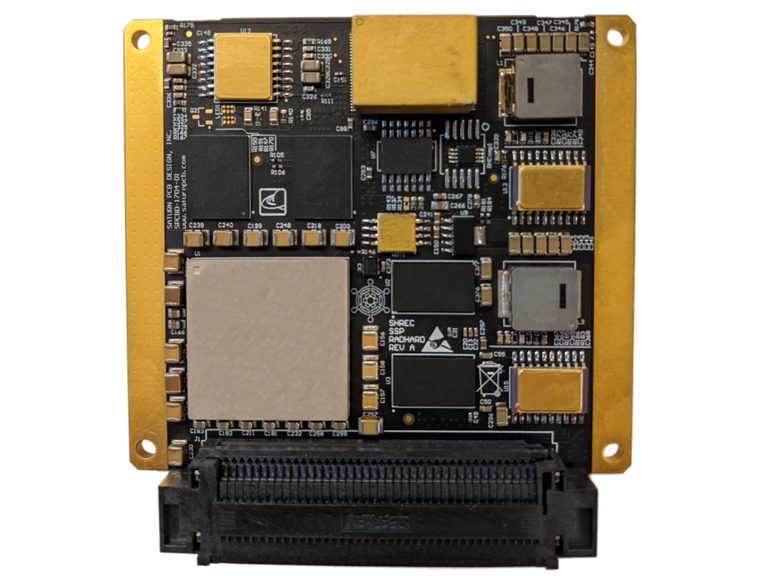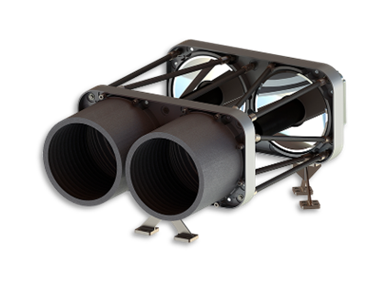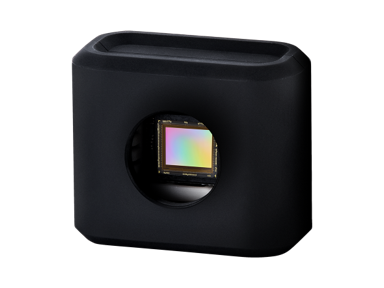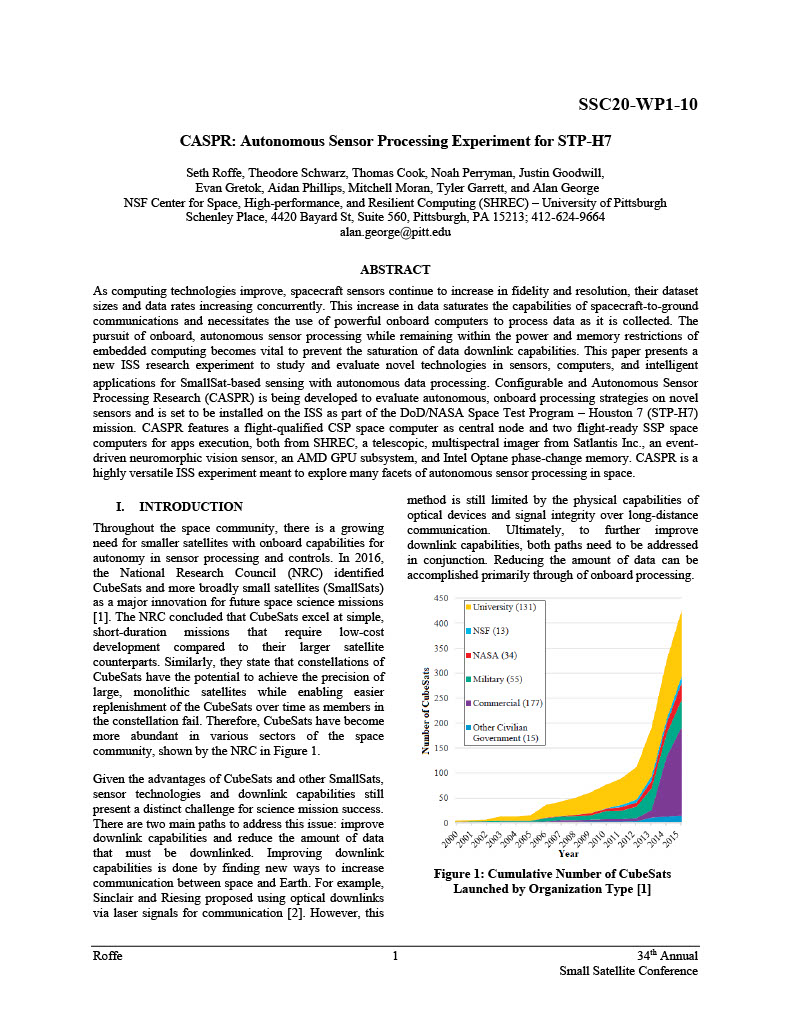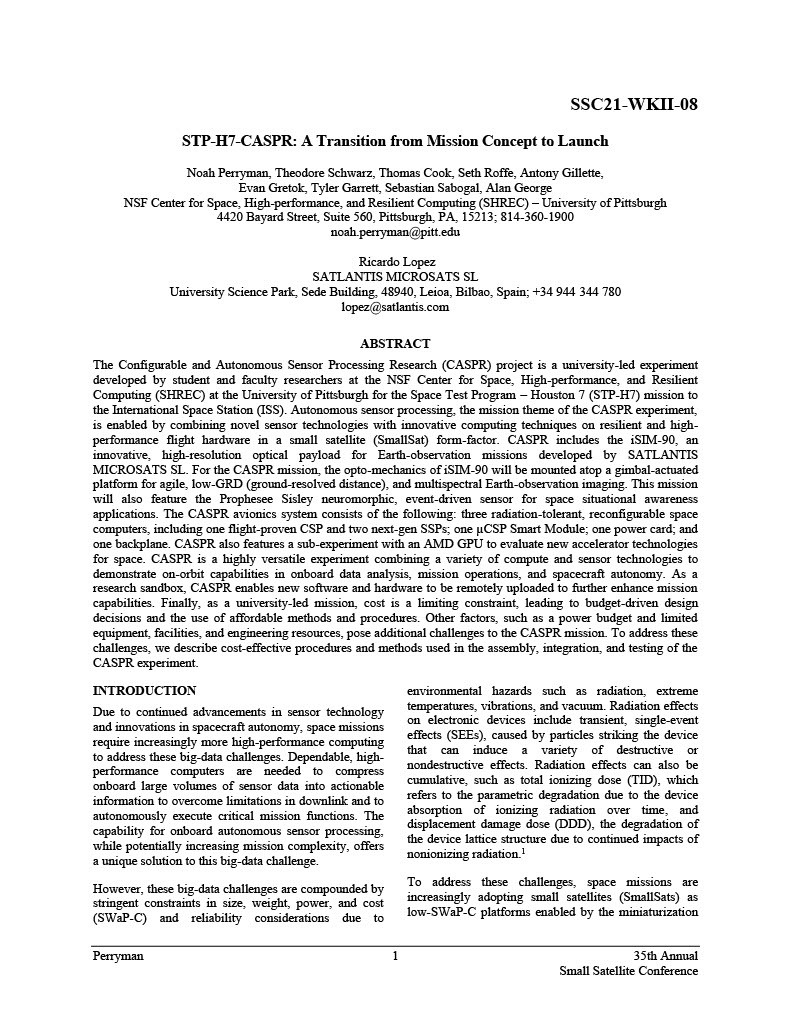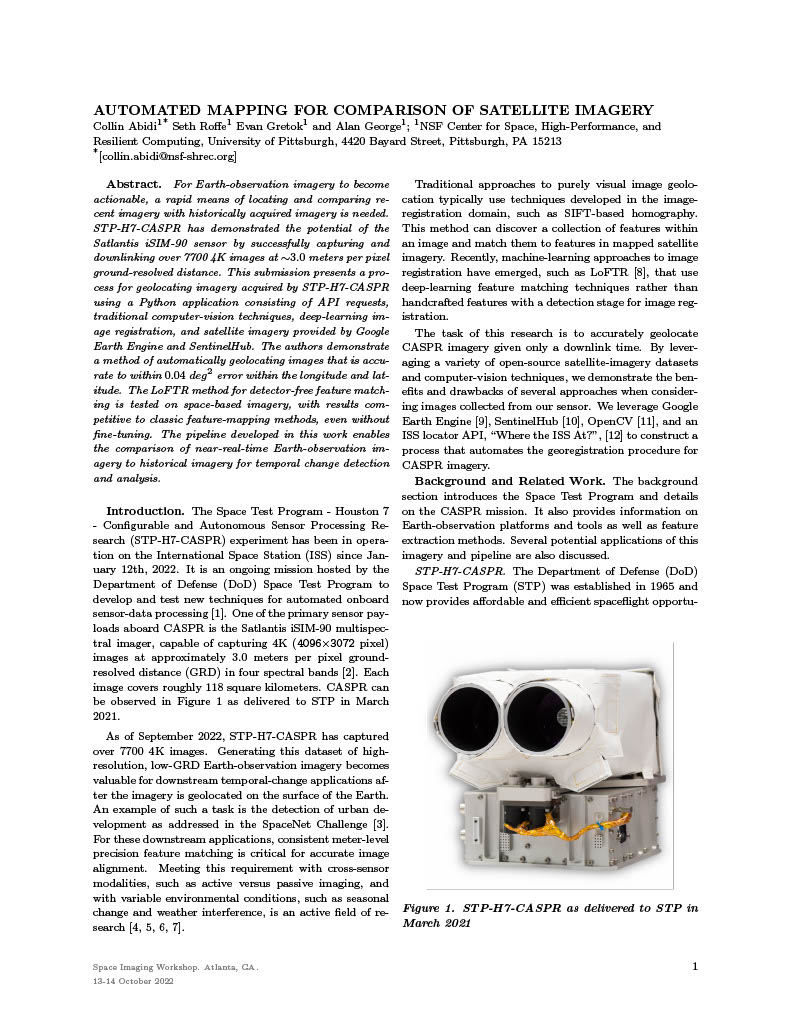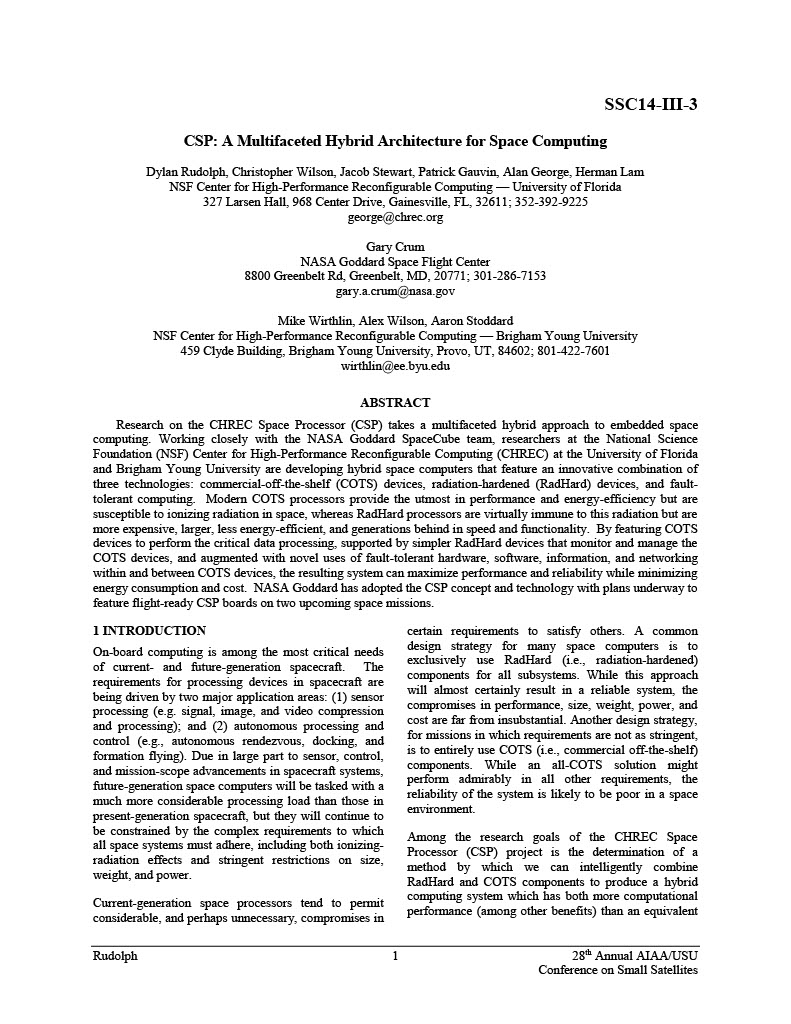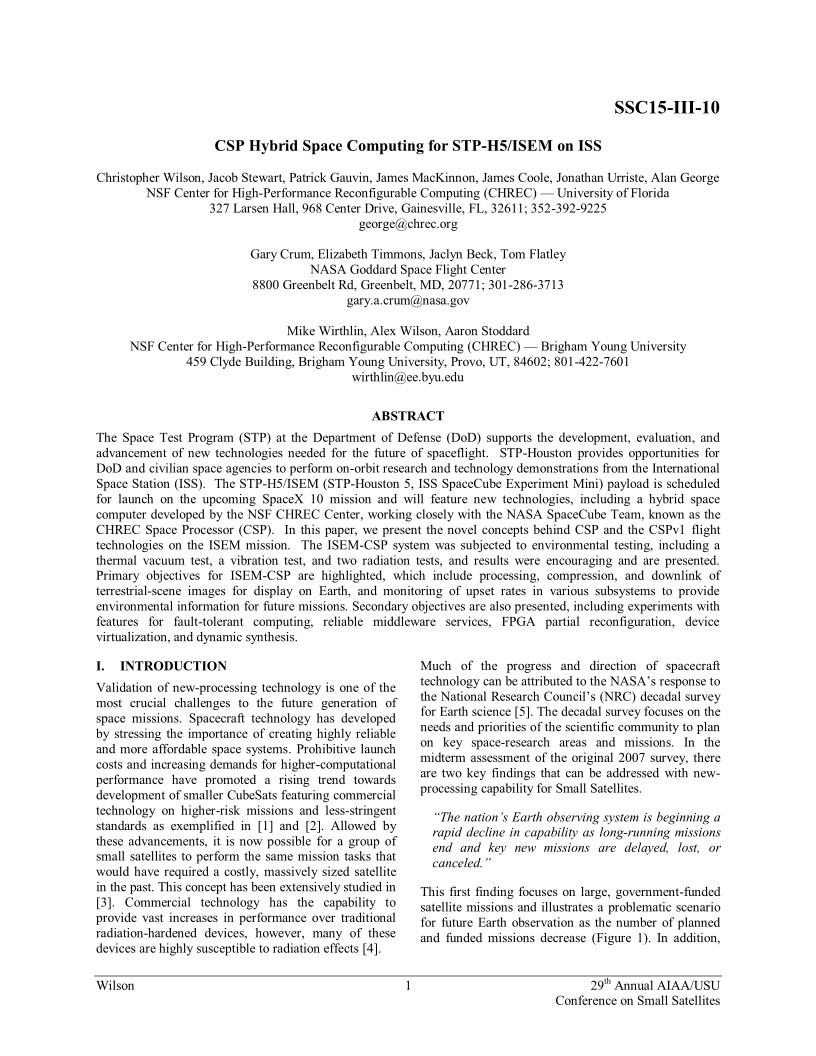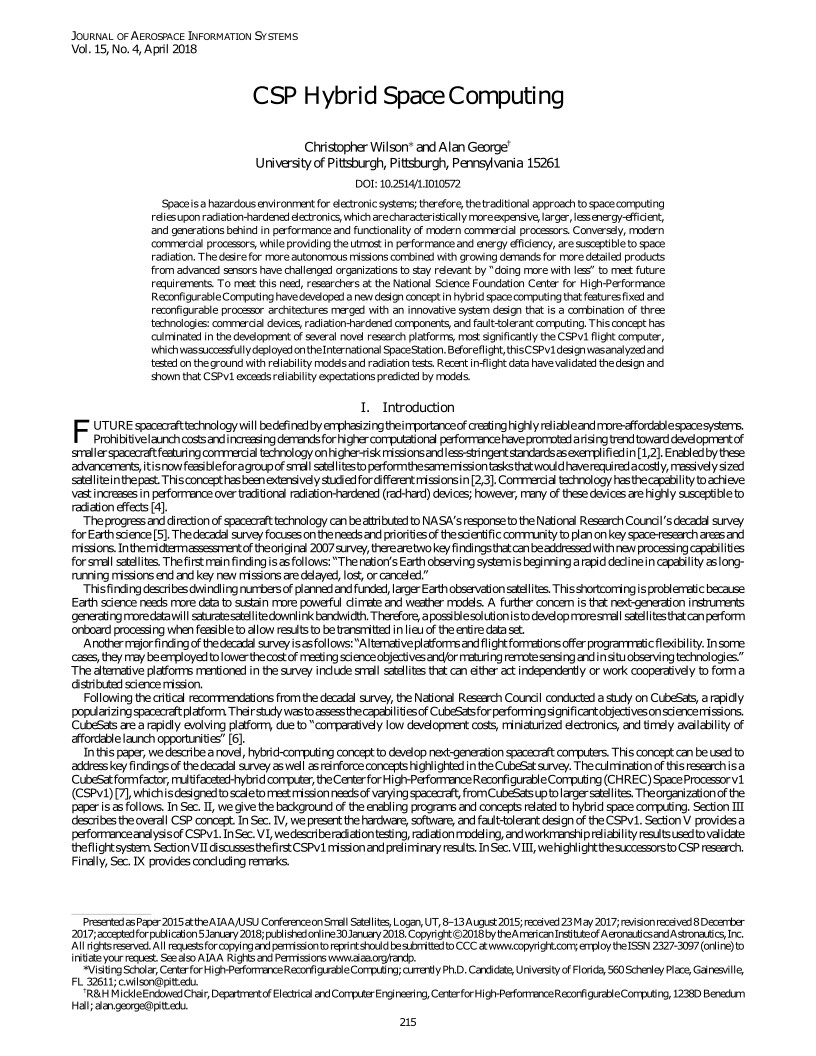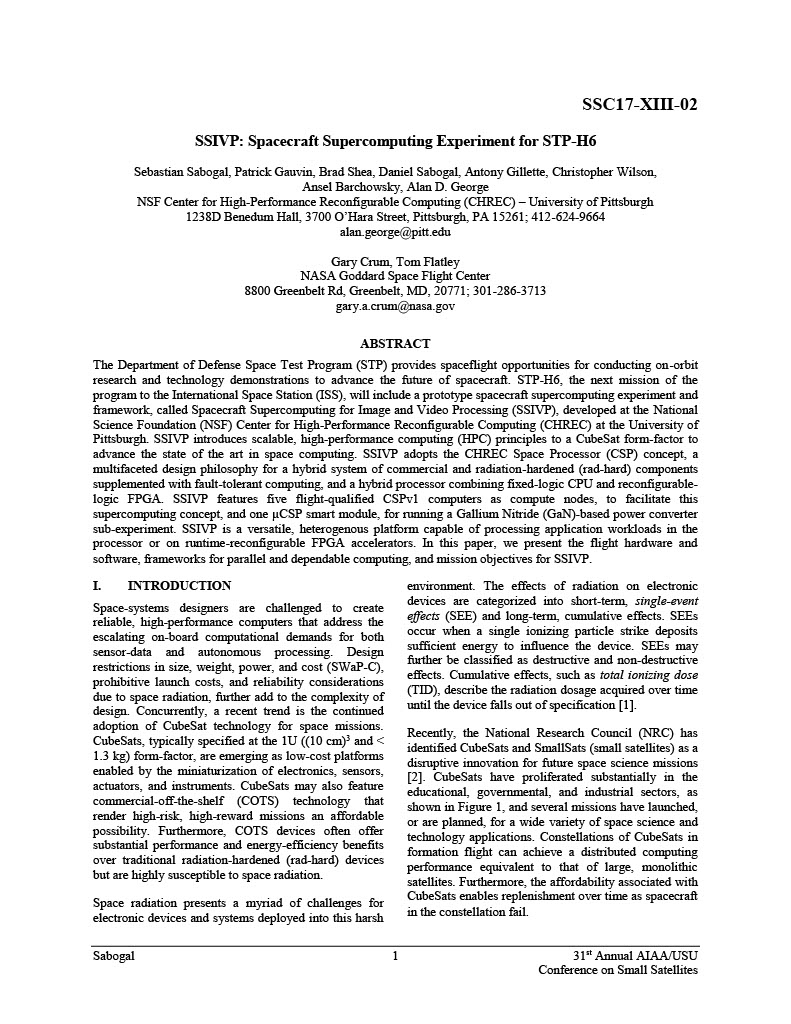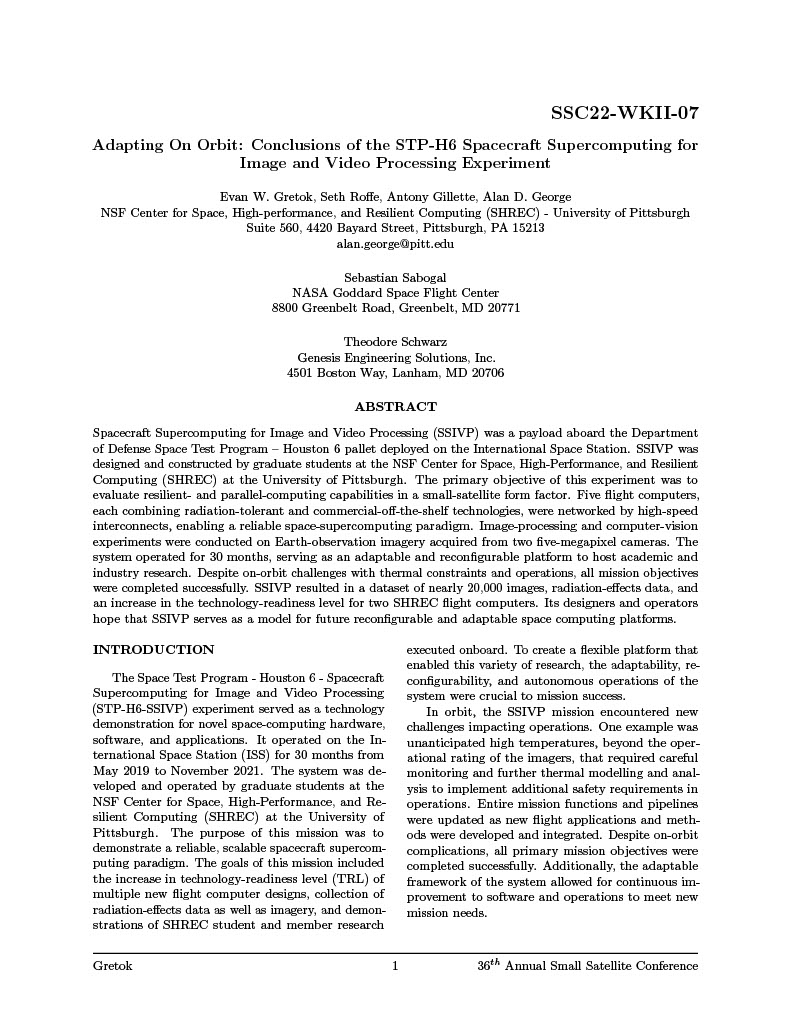About CASPR
Configurable and Autonomous Sensor Processing Research (CASPR) is designed to enable effective onboard processing for next-generation sensors and applications. CASPR is a Department of Defense payload on the Space Test Program - Houston 7 (STP-H7) pallet aboard the International Space Station. It was developed, designed, and built by the students and faculty of the NSF Center for Space, High-performance, and Resilient Computing at the University of Pittsburgh. Explore below to learn more about this exciting research testbed.
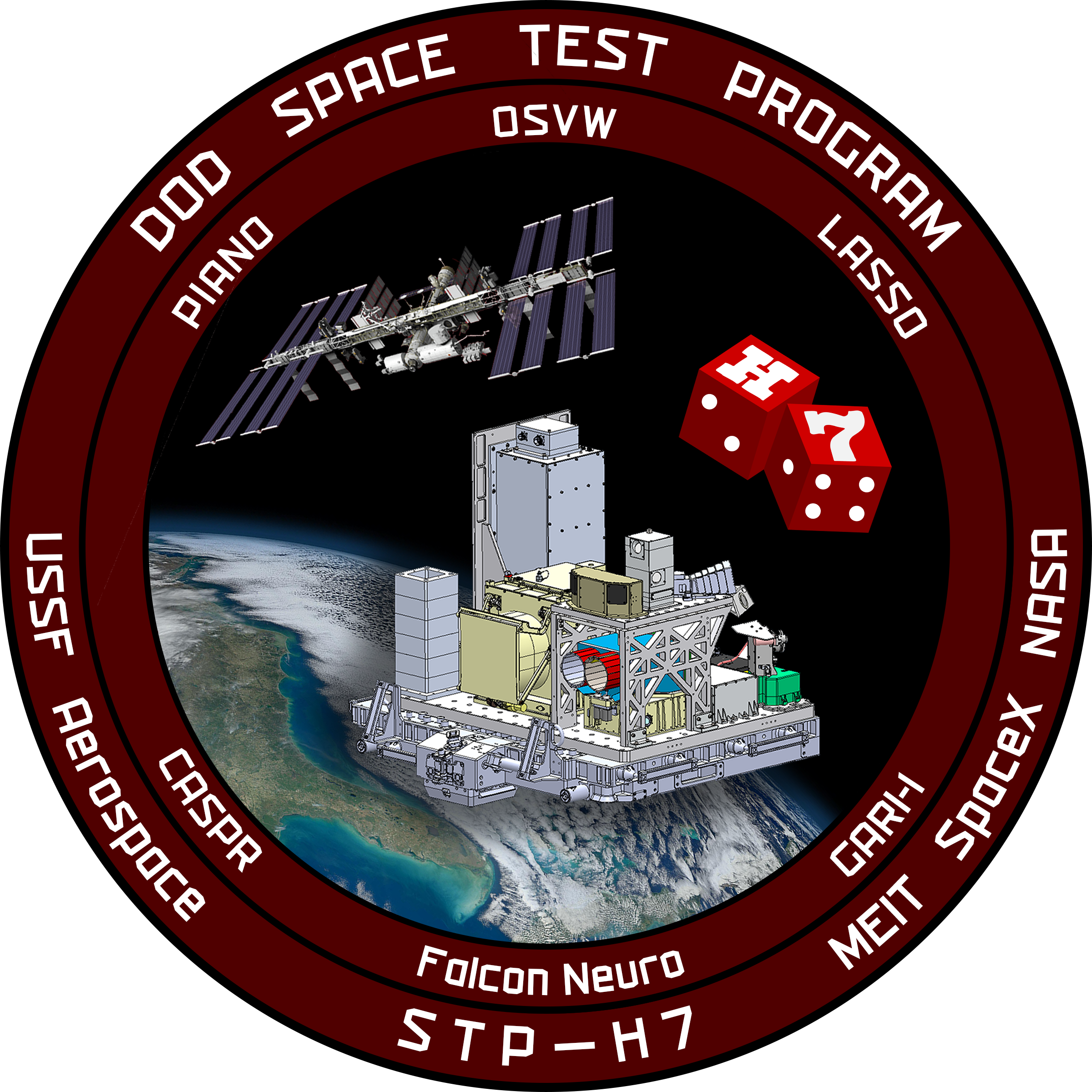
Command Logs
Explore the latest from the students commanding CASPR.
Command training session for Dikchhya! Explored basic functions and SGPU capabilities, especially as they relate to future onboard few-shot learning apps!
Another commanding session for Jakob! Exploring cFS functionality, flight software architecture, schedulers, and apps!
Trained Myles for VANTAGE commanding and apps! Imaging with various camera settings and exploring SGPU app options.
Command Logs
Command training session for Dikchhya! Explored basic functions and SGPU capabilities, especially as they relate to future onboard few-shot learning apps!
Another commanding session for Jakob! Exploring cFS functionality, flight software architecture, schedulers, and apps!
Trained Myles for VANTAGE commanding and apps! Imaging with various camera settings and exploring SGPU app options.
No commanding today due to EVA, but watched activities from SHREC while planning VANTAGE improvements!
Rich’s first full commanding session in preparation for VANTAGE! Radiation effects, power architecture, and SGPU functionality covered!
Completed final CNNJPEG compression stage and downlinked output!
Finally cooled off enough for CNNJPEG! Three compression stages complete!
Downlinked radiation-effects data for processing. Still a bit too hot for a CNNJPEG run.
Planning an imaging sequence of the solar panels, but optics a bit too hot today.
Temperatures a bit too high for the SGPU, so played with uCSP and gimbal settings in the interim.
Error is resolved and the command team is back on the voice loops! No commanding today, but will resume Tuesday.
Diagnosing a minor ground station voice loop issue. Nominal CASPR commanding will resume soon!
Visit from Dr. Bala’s Space Engineering Seminar! We are always excited to host interested students and recruit the next generation of payload developers!
Visit from CMU SEI, one of ou favorite local members! We are excited to work with them on more space projects!
Visit from STP for the STP-H12-VANTAGE PDR! We are very thankful for their support of both CASPR and VANTAGE!
Image capture test campaign started yesterday shows frames back to normal. No significant change in thermals.
Rich’s first command training session! GPU powerup was successful, but still running a bit hot today. Unable to complete compression stage.
Jakob’s first command training session! System overview and general commanding. Keeping GPU off until beta angle drops.
Capturing some solar panel imagery. Noted and diagnosing some strange camera issues. No GPU powerup today due to heat.
Another successful full CNNJPEG run on an image previously captured by Linus! Also completed another downlink of radiation-effects data from all platforms.
First command training session with Dikchhya and Nischal! First steps toward another CNNJPEG run with one of Linus’s stored images!
Delay in commanding caused by Columbus PDU1 malfunction and associated diagnostics. CASPR remains in a good state!
Downlinked decoder input binaries from previous run for further testing. Completed another full run to verify all output sizes and checksums.
Completed first full CNNJPEG inference on orbit! Output has been downlinked at sent to Diego at AFRL for analysis!
Commanding delayed due to STP-H7 pallet anomaly. It wasn’t us this time!
Completed CNNJPEG first stages without issue! Conducting some file management to prepare for further stages.
Resolved limited storage issue for CNNJPEG processing! Successfully completed first three layers of compression!
Provided CASPR data and experiment updates to Pitt Space Distinguished Speaker Dr. Andrew Horchler! Thank you very much for your visit and insight!
Showcased CASPR commanding to Pitt ECE Distinguished Speaker Dr. Don Tan! Thank you very much for sharing your time and knowledge with SHREC!
Members of the CASPR team attended the National Conference on Undergraduate Research in Pittsburgh to help recruit the next incoming class of Pitt Space graduate engineers!
Demonstrated CASPR operations to SHREC Members from Northrup Grumman! Thank you very much for your visit and support!
Conducted extensive flatsat testing to help resolve a CNNJPEG bug dealing with limited storage memory and swap size.
Working to resolve an issue with SSP1 and grainy image burst capture. Also performed some diagnostics on SGPU swap space for CNNJPEG!
Demonstrated CASPR operations to PA Secretary of Policy and Planning Akbar Hossain! Thank you very much for your visit and support!
Downlinked additional radiation effects data from computing platforms! Also performing some SSP network testing while on console!
Working to downlink final missing sections for Nueva Guinea burst! The full set of CASPR imagery will soon be complete!
Successfully tested image prep stage of CNNJPEG! Preparing for next steps!
The CASPR team is presenting our latest data and updates to SHREC members at the annual workshop in San Antonio, Texas! Many thanks to Southwest Research Institute for hosting!
Happy holidays from the CASPR team! We will be away for a few weeks, but will return for more commanding in the New Year!
Downlinked another round of radiation-effects data from CSP and SSPs! Preparing for on-orbit CNNJPEG tests, but this has been delayed slightly due to high beta angle and resultant high temperatures.
Began another downlink of Guinea burst for verification and complete reassembly of segments on the ground!
Successfully decompressed, split, and recompressed New Guinea burst onboard and began downlink!
Completed, recombined, and decompressed Palermo burst on the ground! Cleared space on GPU system for further experiments, including CNNJPEG!
Demonstrated CASPR operations to visitor from Lockheed Martin! A few manual transfers of Palermo burst segments.
Began downlink of NIR/R half of Palermo burst!
Successfully split compressed Palermo burst on orbit, recompressed in smaller halves, and began downlink!
Demonstrated CASPR operations to visitors from Sandia National Laboratories!
Manually downlinking remaining stored frames!
Quick automation to downlink stored frames successful! First round completed 25 of 47 without LoS effects!
Completed downlink of first set of stored student frames! Investigating some quick automation for the remainder.
Beginning manual downlinking stored frames! Testing new method of splitting compressed bursts on orbit.
Preparing commands to decompress and recompress large Nueva Guinea and Palermo bursts onboard! Downlink should begin during next window!
Completed NIR/red half of cloudy Pittsburgh burst! Started another transfer of green/blue portion to make up for some communication losses during last attempt.
Brought down another several months of radiation-effects data! Starting downlink of green/blue filter portion of Pittsburgh cloud burst!
Successfully downlinked remaining half of San Juan burst! Compressed and began downlink of cloudy Pittsburgh burst!
Successfully downlinked a stored partial burst from near San Antonio, Texas! Unfortunately, this burst is mainly cloud cover.
Compressed burst attempt captured back in April over Texas and began downlink!
Reviewing downlinked burst data and working toward color imagery pipeline! More downlinks next week!
Completed downlink of Merritt Island burst! Began downlink of Palermo, Italy burst!
Debugging a slight anomaly with second half of Merritt Island burst. This one is worth the fight, though!
Acquired last few lost segments of first half of Merritt Island burst! Halfway there!
Downlinking second half of Merritt Island burst!
Completed downlink of San Juan burst! Unexpected parts of denser urban area visible further down the frame!
Completed downlink of Santo Domingo burst! Unique cityscape with multiple airports!
Began downlink of Merritt Island burst! Collected another round of radiation-effects data.
Successfully uploaded CNNJPEG image compression app for on-orbit study! Shout out to Diego and Tyler for their hard work!
Began downlink of San Juan burst! Tested image conversion commands for coming app upload.
Downlinking single-frame images stored in memory from previous CASPR location! Began downlink of Santo Domingo burst!
As the CASPR team begins summer internships, and with CASPR’s imaging mission complete, there will be short break in commanding. More updates coming soon!
Completed final segments of Volcan Domuyo, Sanxenxo, and Melbourne bursts! A new daily record!
Conducted downlink of channel one of Santo Domingo burst!
Completed downlink of Qatar burst!
Began downlink of first channel of Qatar burst!
Completed downlink of remaining segments of Constitucion and Limone sul Garda bursts!
STP-H7-CASPR has been successfully moved to the Columbus EPF SOZ site! While CASPR’s Earth-observation mission has ended, its space-computing mission continues!
Final day of imaging! Burst attempt over the Pittsburgh airport had perfect aim, but was mostly cloud cover.
Downlink of additional segments from Garda and Constitucion bursts! Scheduled two bursts for this evening!
Manual burst attempt of Long Island, New York, but only one channel was captured. Started downlink of burst near Limone sul Garda, Italy!
Additional manual downlink of burst segments. Programmed one overnight burst target!
Starting downlink of Volcan Domuyo burst! 11 bursts currently stored onboard CASPR!
Back-to-back manual burst successes near San Juan, Puerto Rico and Cape Canaveral, Florida! Lots of data operations! Additional burst attempt scheduled for this evening!
Lots of burst capture data movement. Began downlink of Melbourne burst! Two more burst targets this evening!
Down to only four segments remaining for San Salvador burst! Started downlink of burst near Sanxenxo, Spain! 12 bursts stored onboard!
Downlinked new round of radiation-effects data! Beginning downlink of San Salvador burst! Two more bursts scheduled!
Manually completed last few segments of Geelong and Plymouth bursts! Started downlink of Constitucion burst. Two more burst targets programmed!
Race track near Melbourne, Australia visible in one of the 3/8 bursts! Began downlink of burst near Plymouth, Massachusetts! Two more bursts scheduled!
Poor downlink window today. Conducting manual imaging and storing on SGPU for use on future ML/CV apps after the move!
Completed manual downlink of last few segments of coastal burst near Tokyo! Two more targets programmed!
Completed the Chattanooga burst downlink and began another! One target programmed!
Completed downlink of a burst captured near Chicago! Began downlink of Chattanooga burst. Programmed one burst attempt as memory remains stuffed full!
The CASPR team has received clearance to continue commanding and will resume nominal operations on Monday!
Due to a minor bug with the move, STP-H7 was moved back to Columbus EPF SDX! CASPR has received a surprise extension to its imaging mission and continues to collect data!
CASPR’s imaging mission has concluded! STP-H7 is being moved from the Columbus EPF SDX site to the SOX location!
Last image capture window yields many manual frame captures as well as bursts of Geelong, Australia and two volcano attempts in Central and South America!
Completed and combined Boston burst! Captured and compressed burst of Yuba City, California. Programmed two more burst attempts overnight.
Captured and compressed bursts of Santo Domingo, Dominican Republic and Constitucion, Chile! Another attempt at downlinking the Tokyo burst.
Manually downlinked last two segments of Klamath Falls burst and recombined! Programmed two overnight burst captures.
Short window, but was able to begin downlink of Boston area burst.
High temperatures prevent GPU activity today. Boston burst remains on the SSP burst buffer, One target programmed!
Attempt near Chicago slightly off timing, but still feature rich! Another successful burst near Boston! High thermals affecting GPU today, so downlink slightly delayed.
Successful burst capture near Plymouth, Massachusetts! Downlink of coastal Japan burst started! Two more targets programmed! Eight bursts onboard CASPR!
Manually completed final segments of New Guinea burst! Began downlink of eastern Maryland farmland burst!
Passing right over San Francisco, but 100% cloud cover. Primarily file operations today.
Successful burst near Chattanooga, Tennessee! Two more targets programmed! There will be a record eight bursts stored on CASPR at once!
GPU is back in action today! Conducting some file operations. Downlink of Nueva Guinea burst has begun!
Still a bit too hot for the GPU today. CSP and SSP burst buffers are full, so we are holding off on further bursts until cooldown.
Successful bursts of coastal Japan and rural eastern Maryland farmland! Temperatures a bit too high for GPU powerup, so performing some manual imaging instead!
Bursts of both Klamath Falls, Oregon and Nueva Guinea, Nicaragua both beautiful! Two more bursts programmed! There will be six bursts onboard CASPR!
Completed downlink of Concepcion! Last two attempts cloudy, but two more programmed overnight!
Manually downlinking missed segments of Concepcion burst. Two more overnight targets programmed!
The CASPR team is in Houston this week for the SHREC Annual Workshop! Special thanks to SHREC members for your continued support of the mission!
Completed downlink of the Bahamas burst! Attempt near Dili, Timor-Leste yielded an island shot!
Started downlink of the Bahamas burst! Programmed two weekend burst attempts. There are four bursts onboard CASPR!
Dual burst automation test was a success! Bursts from Khasab, Oman, and the Bahamas were captured successfully! Completed South Chile burst downlink and started Khasab!
Brought down the latest radiation-effects data and the Southern Chile burst! Attempting some automation updates that could enable scheduling two bursts between command windows.
Completed final segments of Canada farmland burst downlink manually! Successfully captured a burst in Southern Chile!
Last bits of manual downlink for Columbia burst complete! Continuing downlink of Canada farmland burst!
While the Provo burst failed due to overexposure, the last segments of the Dublin, CA, burst have been successfully downlinked! Continuing to transfer the Columbia burst!
Compressed and downlinked most of the Dublin, CA, burst! Programming Provo, Utah, burst over the weekend! This will mean a record five bursts stored onboard at once!
Continuing to downlink the Canada farmland burst! Minor adjustments to large file transfer automation to increase success rate.
Toronto area burst mostly farmland, but still worth saving! Compressing on SSP and downlinking since high temperatures are holding up SGPU access for now.
Virginia Beach attempt had a bit too much cloud cover, but a manual burst attempt in Dublin, CA, shows residential development! Scheduled another burst for the Toronto area!
Started downlink of Columbia burst! Cloud cover and loss of signal prevented new burst capture. Scheduled a burst attempt near Virginia Beach tomorrow morning!
Compressed Columbia burst. Attempted another burst capture of San Diego, but timing was just a bit off!
Captured new burst of several small towns in Columbia! A bit too hot for the SGPU today, so will compress next time.
Manually downlinked last 13 segments of Australia burst! No significant burst opportunities today due to cloud cover.
Manually transferred last 11 segments of the San Carlos burst! Compressed and began downlink of Australia burst!
Downlinked radiation-effects data and more segments of the San Carlos burst! Successfully captured another burst near Pinamar, Argentina, just a bit too far off of the coast!
Manual imaging by Tom over Atlantic and African coast! Uplinked Josh’s 12 targets!
Began downlink of San Carlos burst! Uplinked 37 targets from Linus and Stephen!
Completed downlink and recombination of Japan mountain burst! Uplinked 14 more targets from Josh!
Continued downlink of Japan mountain burst! Evan uplinked 5 quick targets!
Began downlink of Japan burst! Another successful burst capture near San Carlos de Barlioche! 23 targets from Linus and Stephen!
Successful burst capture of area near Pittsburgh! Very cloudy, but stored for downlink!
Successful burst capture in mountainous area of Japan! Uploaded 17 targets from Evan and Linus!
CASPR commanding delayed by Pitt IT firewall transmission. Data collection continues without interruption!
Successful long-term test of NAND resilient boot image integrity! All checksums match expected values!
Tyler on console for two burst captures! Successful downlink of latest radiation-effects data!
Minor CASPR technical difficulties resolved quickly by STP! Many thanks for your support and assistance!
Continued downlink of Japan racetrack burst.
Continued downlink of Japan racetrack burst. 14 targets uplinked!
Completed downlink of green/blue filter channel for Japan racetrack burst!
Attempting compression of Japan racetrack burst, but having SGPU issues due to high temperatures.
Successful burst capture of racetrack southeast of Tokyo! Manual imaging by Stephen!
The SHREC team is at SmallSat this week! Come see the latest CASPR imagery and talk with us about our next mission!
Attempted burst capture over Ocean City, Maryland, but just missed it! Some boats visible, though! Uplinked weekend targets, including burst capture over Tokyo, Japan!
Burst capture attempt near Puno, Peru! Downlink started!
Annapolis burst successful with traces of housing developments, but ~90% cloud cover. Manual imaging test pass over South America and Europe!
Manually downlinked last few segments of troublesome Algerian desert burst! Attempted burst capture over rural France too dark. Scheduled weekend burst capture attempt over Annapolis, Maryland!
Mostly ocean views in our difficult imaging orbit today. Attempted burst capture over the Falkland Islands, but too dark for downlink.
Reattempting downlink of Algerian desert burst due to many LoS events. Another burst captured of Baja, California! A bit underexposed, but stored for next time!
Limited burst opportunities today due to LoS and cloud cover. Began downlink of Algerian desert burst!
No commanding this week due to SHREC Midyear Workshop, but looking forward to sharing latest results with members! Over 27,000 4K monochrome frames and 12 bursts downlinked!
Collected radiation-effects data logs for SMW23. 168 SEUs and 10 MBUs so far! Attempted another downlink of final half of Fort Lauderdale burst, but many LoS-es in this window. Another feature-rich burst capture over Algerian desert stored for next time!
First half of Fort Lauderdale burst complete! Second half started!
Beautiful 20-frame, 2048-pixel burst near Fort Lauderdale, Florida including dense residential and commercial areas with coastal water features! Above threshold for single transfer, so must downlink two channels at a time. First set started!
Manually downlinked remaining three missing segments of Milwaukee burst! Completed stitching, decompression, and assembly.
Updating onboard timing synchronization script for more precise image capture. Continuing to downlink Milwaukee burst!
20-frame, 2048-pixel wide burst near Milwaukee, Wisconsin includes residential, commercial, airport, and lake! Successfully completed downlink of east PA burst and started downlink of Milwaukee burst!
Manual downlink of nine sections of east Pennsylvania burst. Automated transfer of the remainder due to limited command time, but still missing a few segments.
Compression and downlink of east Pennsylvania burst! Another attempt in Florida, but mostly cloud cover.
Completed downlink of north Chile burst! Successfully captured another series of frames in eastern Pennsylvania!
Mountainous burst captured in northern Chile! Downlink started!
Tracked down the timing drift issue that has been causing accuracy issues with scheduled image capture! Working on several fixes to resolve.
Finally completed the Namibian coast burst after three windows of downlink attempts!
Successful test of new burst verification system! Another series of downlinks of the Namibian coast burst.
Three burst captures of the Falkland Islands, the coast of the Republic of the Congo, and southern Chile all show heavy cloud cover. Made on-orbit adjustments to the burst tile verification system.
Captured a beautiful coastal burst near Walvis Bay, Namibia! Started downlink, but only completed 15/42 chunks due to loss of ISS signal.
Too much cloud cover for burst attempt, but uplinked nineteen imaging targets for the weekend. Adjustments to targeting system yielded excellent, cloud-free shot of Santa Barbara, California!
Burst captures near Pittsburgh and New Orleans, but both abandoned due to heavy cloud cover. Testing adjustments to targeting system.
Burst captures near Wilmington, North Carolina and Boise, Idaho, but both were full cloud cover.
Additional command day to expedite downlink of Moncton burst. Successfully stitched, decompressed, and uploaded for Satlantis review and processing!
Successful 2048-pixel wide, 20-frame burst over Moncton, Canada! Best burst yet, with residential development and airport clearly visible! Downlink started.
Manual imaging and preparation for burst attempt, but excessive cloud cover over target area resulted in postponement.
Two 2048-pixel wide, 20-frame burst captures. One over central US ended up being primarily cloud cover. Another targeted Monterey, California! 33 of 37 chunks of this compressed burst have been downlinked! The rest will be retrieved next week.
Completed another 2048-pixel wide, 20-frame burst over the central US. Downlink started! Note high beta angles and heat for the next few weeks.
Reactivated imaging automation for the weekend. Unfortunately, there is insufficient time to attempt another burst.
Attempted downlink completion of previous burst, but encountered minor command anomaly. Adjusted state to prepare for shutdown for EVA on Thursday.
Successful burst capture over Barbados! 38 of 40 segments successfully downlinked in three transfers. Two more to grab next week!
Burst capture attempt in the Azores lost to a minor frame corruption error. Some cloud cover in the area, so not a significant miss.
No commanding this week due to SHREC Annual Workshop! The CASPR team is excited to share our victories from the first year in orbit!
Further downlink of previous burst attempt. Still missing eight of forty-six segments. Reattempting next week.
Successful 2048-pixel wide, 20-frame burst capture over Southern Chile despite limited imaging orbit! Downlink started.
Nominal commanding and preparation for burst attempt, but high temperatures due to beta-angle peak prevented it. Will resume burst capture plans after the holiday break. Happy Holidays from the CASPR team!
Burst capture over Santiago, Cuba. Only one channel acquired due to minor trigger bug. Downlink pending. Assembling and testing burst automation.
Burst capture over Puerto Rico, but there was excessive cloud cover.
No commanding this week due to holiday absence. Happy Thanksgiving from the CASPR team!
No commanding this week due to extravehicular activity.
Burst attempt made over the south of Argentina, but cloud cover was excessive. Poor orbit prevented further attempts today.
Burst attempt over the Falkland Islands yielded only one channel due to minor trigger bug. Second burst attempt over Southern Chile successful.
Downlinked radiation-effects data for November. Attempted long-swath, 40-frame burst capture over Montevideo, Uruguay, but experienced more cloud cover than expected.
The CASPR operations team is at the Space Experiments Review Board meeting to present the final outbrief of the STP-H6-SSIVP mission.
Manual imaging over Canada, the United States, and Africa. Burst attempt was made, but there was excessive cloud cover.
Pulled last eight compressed segments of the quarter-res burst attempt near Jacksonville, Florida. Successfully merged! Swath length at quarter res stretches more than one FoV with all spectra.
We are attending the 3rd Space Imaging Workshop at Georgia Tech presenting on “Automated Mapping for Comparison of Satellite Imagery” developed for our CASPR imagery.
Captured a forty-frame, quarter-resolution burst near Jacksonville, Florida. Completed partial downlink, but signal loss caused issues with eight of thirty-eight segments. We will complete downlink during the next commanding window.
Captured a twenty-frame, half-resolution burst of the Pittsburgh area, but there was a bit too much cloudcover.
Completed downlink of central Spain burst. Attempted burst capture over US Virgin Islands but experienced issues with green/blue channel. Tested new burst-verification method, but it still has some bugs to work out.
Successful capture of a 20-frame burst of central Spain at half horizontal resolution (2048 pixels)! Downlink attempt is missing several segments due to signal loss, but it will complete Thursday.
Successful downlink of remaining NIR/red half of southern Chile glacial area burst. Attempted another burst capture along the Brazilian coast, but the ground was fully occluded by clouds.
Successfully captured a detailed, mountainous twelve-frame burst over the glacial area in southern Chile! First successful full test of half-burst compression. Successful downlink of green/blue half of burst.
While half of a burst was downlinked, a minor transient frame-grabber bug prevented proper capture. A poor imaging orbit and loss-of-signal events prevented a new burst attempt today.
Successfully tested new half-burst compression method on the GPU. Developed new script for burst thumbnail verification.
Resolved eight-frame limit issue with green/blue filter channel enabling longer full bursts! Working on further splitting solutions to compress and downlink these longer bursts.
Completed downlink of mountainous terrain burst imagery near Oakland, California.
Completed downlink of Freehold burst containing feature-rich suburban area! Captured another burst of mountainous terrain near Oakland, California and currently downlinking.
Reattempted downlink of burst captured over Freehold, New Jersey. Still missing one archive segment.
Attempted capture of first twelve-frame burst over Freehold, New Jersey. Poor downlink window due to losses. Will have to reattempt downlink on Tuesday.
Captured nine-frame burst over Montreal, Canada, while testing updates to split and downlink method. Burst was downlinked successfully but overexposed due to unanticipated cloud cover.
We’re at SmallSat 2022! Visit us at the “University of Pittsburgh - NSF SHREC” university exhibit to learn more about our exciting work.
Captured burst over Liege, Belgium, and transferred the burst to the GPU for compression. Attempted downlink of the burst images with partial success.
Downlinked radiation-effects data for June and July. Attempted another burst capture, but downlink only partially complete.
Loaded new schedule for targeted imaging over the weekend.
Completed downlink and verification of first complete nine-frame burst of images from southwest Bolivia.
Verified proper output on Lockheed Martin PSF deconvolution GPU app. Developed and tested a method to offload iSIM-90 frames and compression to the GPU. Downlinked 33 of 39 segments of an image burst near Sucre, Bolivia. The remaining six segments will be downlinked next week.
Retrieved burst segments affected by missed packet issue from NASA backups. Attempted manual downlink.
Successfully captured a burst of nine image frames over eastern Virginia but downlinked only 14 of 35 file segments due to loss of signal. Continuing to work on improved compression and downlink methods.
Completed first successful large file downlink of Lockheed Martin PSF deconvolution GPU app output data!
Created new golden-file list for redundant file storage on GPU. Re-ran Lockheed Martin SSP app and transferred good results to GPU.
Integrating upload into GPU file redundancy and generating MD5 checksums.
Cleaned temporary files on CSP and SSPs. Performed backup of scripts between boards.
Lockheed Martin PSF deconvolution app run successfully on GPU! Log files downlinked for analysis. 10 frame burst captured over New Orleans, LA!
Lockheed Martin PSF deconvolution app run on SSP. Output successfully transferred to GPU! First attempt at running GPU version of PSF deconvolution.
Debugging interface issue with neuro sensor. Downlinked radiation-effects data from CSP and SSPs. Lots to see here! 10-item schedule uplinked!
Transferred upload to GPU and began unpacking. Testing new neuromorphic app and scripts. 30-item schedule from SHREC student James uplinked.
First CASPR upload file transfer successfully completed! Successful verification of MD5 sums in /cf/ and NAND!
Successful capture of 17 of 18 burst frames - channel2 missing one frame again. Found workaround for memory management issue.
Almost a successful nine-frame burst! Missing one frame in channel two. Successful compression of 8.5-frame burst! Testing large file transfer script and working to resolve memory management issue.
Uplinked 33-item schedule for the weekend. Fixes to large transfer script and test with ~12 MB dummy data. Successful recombination of full file on the ground! MD5 checksums match! First attempt at nine-frame burst capture.
Made minor modifications to SchedGen for date and confirmation downlink. Uplinked 18-item schedule. OCR process for first upload started - scheduled for GMT125!
v1 of SHREC student Mike’s SchedGen schedule generation script uploaded! 34-item list of target times from SHREC student Collin’s first targeting campaign uplinked.
26-item schedule uplinked! Some manual captures by SHREC Center Director Dr. George! Working on large file transfer script to simplify burst downlink.
Captured another burst over western Montana. Testing compression of frames for downlink. However, we’re only getting compression ratios of ~0.5.
First successful burst on both SSPs from multiple imagers after AutoSR script adjustments! 81-item schedule uploaded!
30-item schedule uplinked and verified. Successfully captured burst of six images to SSP0! No images captured to SSP1 and no transfer of files to CSP.
SHREC student Mike grabbed frames of Mexico, Pittsburgh (though cloudy), France (coast), and Sicily! 20-item schedule uplinked. TF v1.14.0 and CV2 v3.2.0 verified functional on the GPU
35-item schedule uploaded - double-visit of Dusseldorf, lots of US targets!
Performing calibration and testing of targeting system accuracy now that most bugs have been resolved.
GPU is healthy and active with valid OpenCL at reasonably high temparatures! Uplinking new 46-item target list with no general automation to check behavior.
The Space GPU is alive! CLINFO shows a valid GPU device!
Uploaded 66-item schedule with lots of worldwide coverage! New method seems to have fixed the duplication bug!
Further attempts to fire ERMs. More Lockheed Martin app runs and attempts at large file downlink.
First successful NAND recovery run from GPU to SSP0! Two more successful Lockheed Martin app runs with log files downlinked. Downlinked upset data from CSP, SSP0, and SSP1.
50-item schedule uplink with new strategy to avoid conflicts with naive automation. Checked scrubber logs and seeing some interesting results thus far.
First successful commanding of the GPU! GPU device is detected and functional!
Successful GPU powerup and interfacing! Still working on command and data transfer to and from the GPU. Further Lockheed Martin app runs.
First successful run of HOTS neuromorphic classification in space! Further LM app runs with output data compression to assist with large file downlink attempts.
Further Lockheed Martin app runs and efforts toward large file downlink of results. Successfully integrated naive automation with schedule manager.
Further Lockheed Martin app runs. Working on integrating naive automation with scheduled targets to prevent interference.
40-item schedule uplinked, including targeting for Singapore, Dubai, and Sydney! Testing preservation of some images in NAND to prevent missing downlink during loss of signal.
Further gimbal attempts and some manual imaging.
First successful run of Lockheed Martin PSF deconvolution app on orbit! Working on large file downlink for the output.
First successful image scheduling! Continued work toward GPU powerup.
Ejected release modules triggered! First attempt to open the gimbal. Trying different torque settings.
Back after twelve days offline due to payload anomaly. Naive automation restarted.
First successful test of on-orbit task scheduling!
Downlinked first set of radiation-effects data from both SSPs! Experiencing artifacting with some images.
Downlinked first set of radiation-effects data from CSP! Also verified correct receipt of ISS timing.
Captured an excellent shot over a coastal town in Panama with a visible marina. Beginning attempts to power on the GPU.
Initial naive automation showing excellent results! Imaging attempts of South America and London. Power mode safed for overnight cooldown.
Single-frame tests continue to work nicely. Sun elevation angle makes higher exposures necessary early and late in the day. Night-mode imaging is unsuccessful even at very long exposure times. Thermals heating up. Fixed a few small parser issues.
Tried for night-mode imaging. Also verified ISS timing and command delay.
Single frame capture was successful! Conducted some exposure time calibration. Settled on 350 µs for the time being.
Completed sed adjustments to autoFrame script. Frame capture is successful, but we are having some issues with automatic downlink. Continuing to investigate neuromorphic sensor crashes, but LSUSB and DMESG look great!
Working to remedy empty data file issue from neuromorphic sensor. Also reworking some aliveness test scripts.
Received non-empty neurodata, but still nothing distinguishable. Fixed relative pathing issue with some commands.
Captured 10, 30, 45, and 60 second records of neuromorphic event data. Thermals still looking great. Aliveness test successful! Prep and compute power modes operate as expected.
First nominal commanding of CASPR! General CSP commands are functional. Power status is safe with all off as expected. uCSP thermal reporting is working through UART.
CHREC Space Processor
Hybrid Space Computer

Designed by SHREC students, CSP is one of the first computers containing commercial-off-the-shelf (COTS) and radiation-hardened components to provide a radiation-tolerant yet powerful computing for space. CSP employs a Xilinx Zynq-7020 system-on-chip containing an Artix-7 FPGA fabric and a dual-core ARM Cortex-A9 processor.
Boards available for purchase from Space Micro Inc. via their licensing from SHREC, or IP available to all SHREC members.
SHREC Space Processor
Next-Gen Hybrid Space Computer
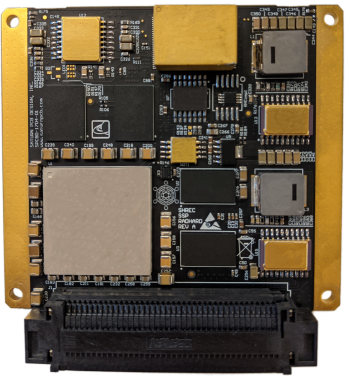
Designed as a successor to the CSP, the SHREC Space Processor (SSP) provides the same hybrid-computing concept with more FPGA acceleration power. SSP employs a Zynq-7045 system-on-chip with a Kintex-7 FPGA fabric and a dual-core ARM Cortex-A9 processor, supporting the addition of multi-gigabit transcevers and dedicated programmable-logic DDR memory.
Boards available for purchase from Space Micro Inc. via their licensing from SHREC, or IP available to all SHREC members.
Satlantis iSIM-90
Multispectral, High-Resolution, Low-GRD Imagery
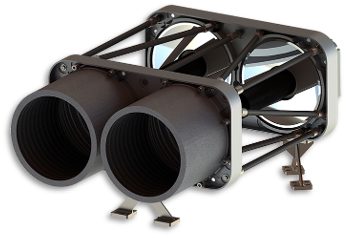
Designed and built by SHREC member Satlantis, based in Bilbao, Spain, the iSIM-90 can achieve a ground-sampled distance of <2.0 m from an altitude of 500 km. The sensors cover the visible and near-infrared (VNIR) spectral range.
For more information, visit the Satlantis website.
Prophesee Sysley Event-Based Sensor
Neuromorphic, Event-Based Vision
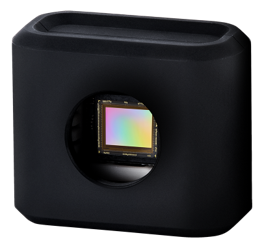
Designed and built by Prophesee, based in Paris, France, the neuromorphic sensor is an asynchronous event-based vision sensor modelled after the human eye. The sensor’s biomimetic model ignores any redundant, static background information in its field of view, passing only moving events measured by luminosity changes. This method of capture provides a very high dynamic range (>120 dB) and a low temporal resolution (on the order of microseconds).
For more information, visit the Prophesee website.
Timeline
From design to online
-
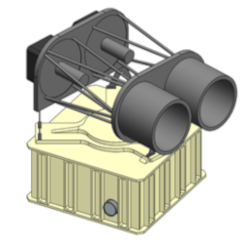
August 2018
Original Design
Proposed the original design of CASPR
-
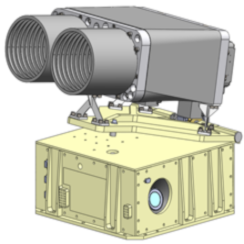
October 2019
Preliminary Design Review
Showcased mission goals and development progress
-
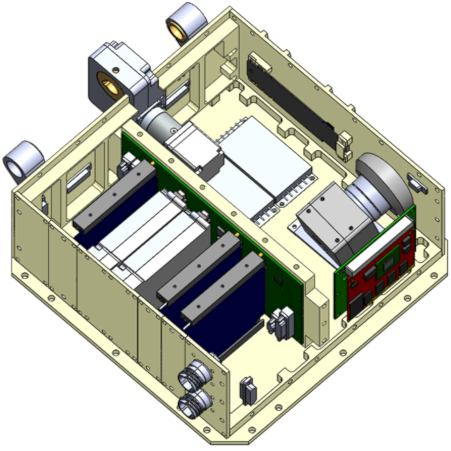
April 2020
Critical Design Review
Finished up the design
-
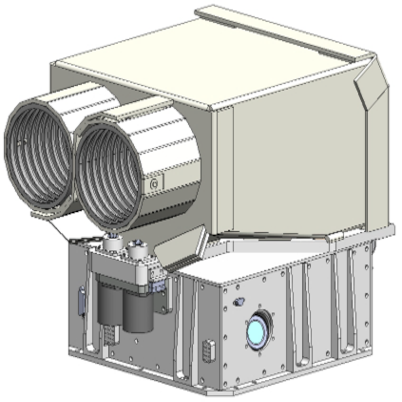
November 2020
Field Configuration Audit
Ensured system meets all specifications
-

February 2021
Flight Unit Assembly
Prepared the flight unit at our Pitt lab
-

Early March 2021
Environmental Testing
Performed thermal and vibration testing
-
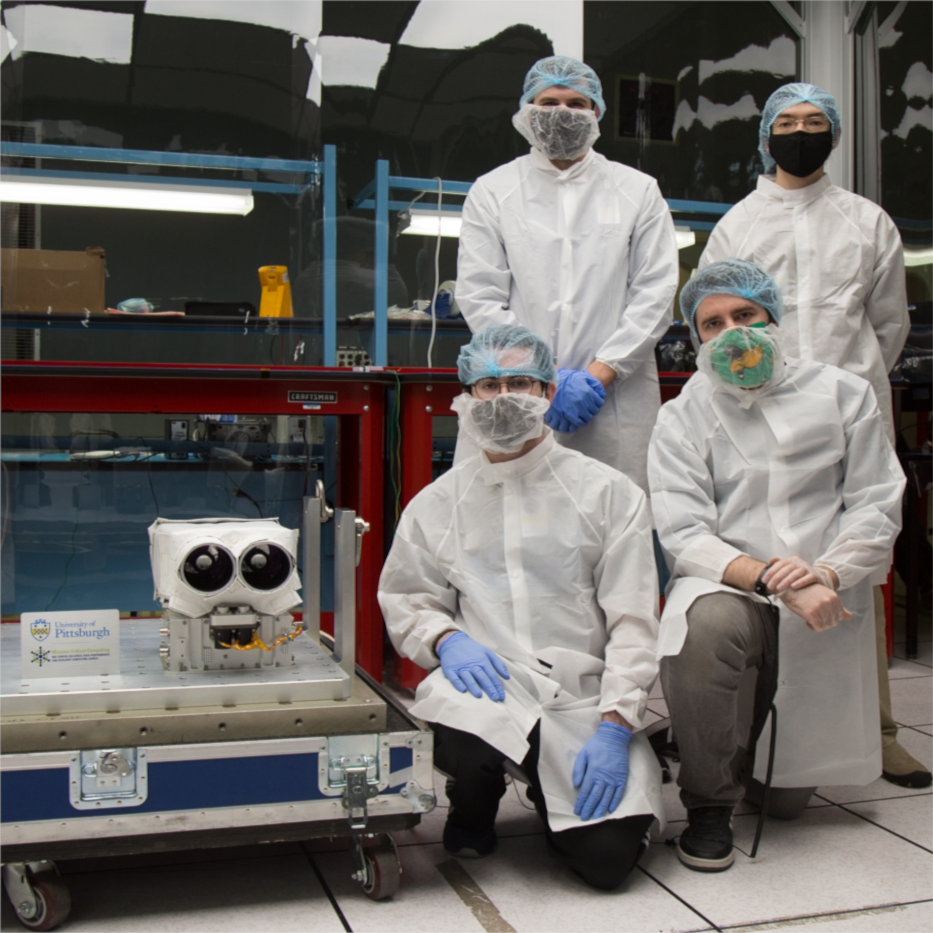
Late March 2021
On-Dock Integration
Delivered CASPR to NASA Johnson Space Center
-

September 2021
Software Upload
Updated the software with new apps
-

December 2021
Launched aboard SpaceX CRS-24
-

January 2022
Installed as part of the STP-H7 pallet on the outside of the Columbus module
-

January 2022
Initial Commanding of CASPR
Sent the first commands from our lab at Pitt
-
CASPR
operations
underway!
Main Partners
NSF-SHREC and STP-H7-CASPR are funded by industry and agency members and by the IUCRC Program of the National Science Foundation under Grant No. CNS-1738783. We would like to specifically thank the following companies and agencies for their support:
The Department-of-Defense’s Space Test Program oversees the STP-H7 pallet which hosts CASPR.
The Naval Research Laboratory provided access to their environmental testing equipment and donated components.
The NASA Goddard branch helped with designing the electronics.
Texas Instruments donated power components used on CASPR.
Publications
Click to see publications about STP-H7-CASPR.
Seminal works which influenced STP-H7-CASPR.


